In Photos: Space Station Crew's Harrowing Abort Landing After Soyuz Launch Failure
Ill-Fated Soyuz Lifts Off

A Soyuz rocket that was supposed to send two Expedition 57 crew members to the International Space Station on Oct. 11, 2018 failed to reach orbit after an anomaly occurred with one of the rocket boosters. NASA astronaut Nick Hague and Russian cosmonaut Alexey Ovchinin aborted the mission and returned to Earth in a ballistic reentry. Click through this gallery to see photos of the rocket and the crew before, during and after the launch. [Full Story: Soyuz Rocket Launch Failure Forces Emergency Landing for US-Russian Space Station Crew]
The Soyuz Crew
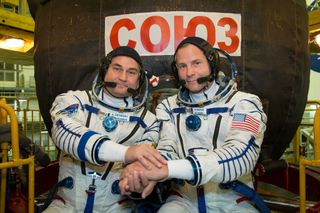
Russian cosmonaut Alexey Ovchinin and NASA astronaut Nick Hague pose in front of the Soyuz spacecraft during prelaunch training Sept. 26, 2018.
Heading to Launch

Donning his flight suit, NASA astronaut Nick Hague walks arm-in-arm with NASA's Associate Administrator for the Human Exploration and Operations Directorate, William Gerstenmaier. To the right is NASA administrator Jim Bridenstine. [NASA Administrator Promises Investigation into Astronauts' Emergency Landing After Soyuz Failure]
Crew Farewells
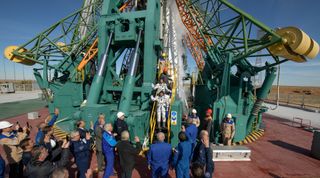
NASA astronaut Nick Hague and Russian cosmonaut Alexey Ovchinin wave goodbye as they board the Soyuz. They thought they would be leaving for six months, but they returned to Earth much sooner than they anticipated.
A Successful Liftoff
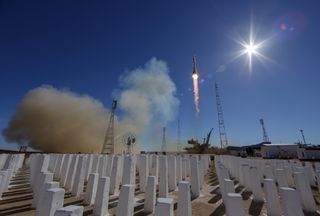
The Soyuz rocket takes to the skies in this ominous view from the Baikonur Cosmodrome. While those white columns might look like tombstones or some kind of memorial, the array is actually designed to protect an underground bunker that houses the launch control center. In the event of a launch failure at or near the launchpad, the pillars would help to break apart the rocket before it hits the ground, lessening the severity of the impact underground.
Launch Closeup
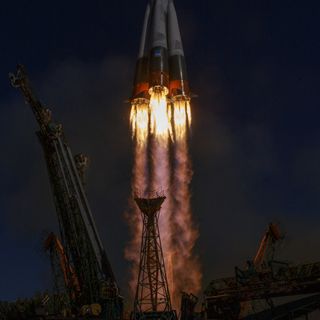
The Soyuz rocket lifts off from the Baikonur Cosmodrome in Kazakhstan. Everything seemed to be going according to plan for the first few minutes of the launch.
So Far, So Good?
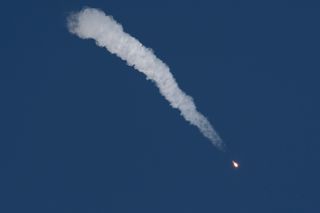
The Russian Soyuz rocket is seen shortly after it lifted off from the Baikonur Cosmodrome in Kazakhstan. After one of the rocket boosters failed during the ascent, the launch was aborted, and the crew capsule returned to Earth in a ballistic landing.
Get the Space.com Newsletter
Breaking space news, the latest updates on rocket launches, skywatching events and more!
The View from Space
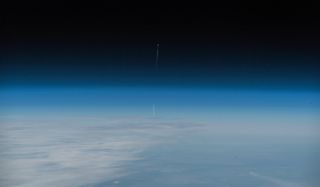
European Space Agency astronaut Alexander Gerst snapped this photo of the Soyuz from the International Space Station. "Glad our friends are fine," he tweeted. "Today showed again what an amazing vehicle the #Soyuz is, to be able to save the crew from such a failure. Spaceflight is hard. And we must keep trying for the benefit of humankind."
Before the Abort
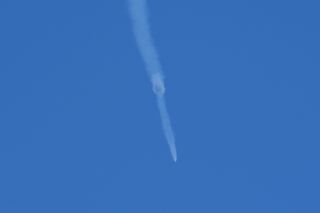
Just before the abort system was activated, everything appeared to be "nominal," a NASA TV commentator said during a live broadcast of the launch.
Escape System Activated

This photo of the Soyuz was taken seconds after the launch escape system was activated, separating the crew capsule from the launch vehicle.
A Pillar of Fire
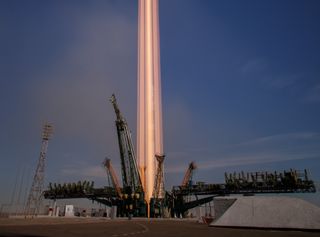
A long-exposure photo shows the flames beneath the Soyuz rocket as it lifts off.
Join our Space Forums to keep talking space on the latest missions, night sky and more! And if you have a news tip, correction or comment, let us know at: community@space.com.

Hanneke Weitering is a multimedia journalist in the Pacific Northwest reporting on the future of aviation at FutureFlight.aero and Aviation International News and was previously the Editor for Spaceflight and Astronomy news here at Space.com. As an editor with over 10 years of experience in science journalism she has previously written for Scholastic Classroom Magazines, MedPage Today and The Joint Institute for Computational Sciences at Oak Ridge National Laboratory. After studying physics at the University of Tennessee in her hometown of Knoxville, she earned her graduate degree in Science, Health and Environmental Reporting (SHERP) from New York University. Hanneke joined the Space.com team in 2016 as a staff writer and producer, covering topics including spaceflight and astronomy. She currently lives in Seattle, home of the Space Needle, with her cat and two snakes. In her spare time, Hanneke enjoys exploring the Rocky Mountains, basking in nature and looking for dark skies to gaze at the cosmos.
